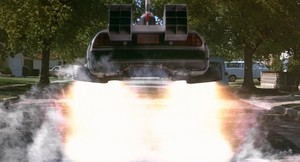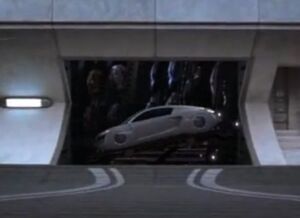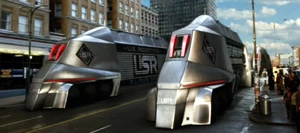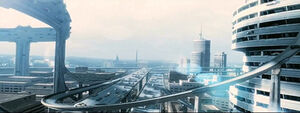
A flying Delorean? Thanks to the Wilson Hover Conversion System

Parking in the Future From I,Robot

Driverless Express Lanes Taken from I, Robot

The Smart Highways taken from Minority Report
"Where we're going we don't need roads."-- Dr. Emmett Brown Back to the Future
Industrial Era 2.0 []
The Wilson Conversion System became even more popular than Henry Ford's own assembly line which revolutionized the automobile industry. This new piece of software and chemical genius sparked a new industrial era in America.
Driverless Testing[]
In 2020 Google chooses ten main highways to test its driverless car system. By 2028 most highways in America are retrofitted with a "driverless lane". This driverless lane is used mostly by larger shipping corporations like UPS and the US Postal Service. Though by 2030 some public owned vehicles get to take it for a test drive. This is part of the US Government's Highway Transportation Overhaul Project set up by President Huntsman.
Highway in the Sky[]
In anticipation of these new smart cars, driverless cars, smart roads, and eventually hover cars. The FAA takes it on themselves to outline a mapping project for their own take on the solution. "A Highway in the Sky."
They dreamed up of everything from hovering stop signs to smart infrared roads that the future cars would travel along. The project would take nearly forty years and $6 Trillion just to start the testing phase which only began in the 2030s.
The First Hover Cars[]
The first hover cars were crappy ultra-expensive luxury vehicles that you needed a pilot's license to use. Rolls Royce, Lexus, and Lamborghini were some of the first companies to introduce the vehicles. They cost twice as much as their driven counterparts. So if a Lamborghini would cost you $1 Million a hover one would cost $2 Million. If the Lexus cost you $60,000 the hover version would cost $120,000.
Criticisms []
The Hover Cars were not very popular when they first came out. People perferred road cars because Road Cars were very fast, had good gas mileage, were super safe, and basically did everything themselves. When you bought a hover car, you were basically buying a small plane, that you had to fly yourself!
More criticisms came from the aviation industry itself. This is an industry that has basically shifted to complete AI systems by 2035 and not one "pilot" was hired after 2020. The Aviation industry believed that the hover cars were interacting with the daily operations of the computer networks that controlled airplanes. Which they still lamented was the safest way to travel. Despite the fact that a hover car could crash into an airplane by a drunk flyer.
Drunk Flyers[]
In the wild west stages before the highway in the sky was complete, many rich celebrities were testing these hover cars out and they crashed into airplanes on routine flights. The aviation industry routinely had to keep up with new ways these celebs were finding ways around their laws. Still they were actively hoping that they could come up with a safe method to allow these hover cars to be made available to the general public. The Highway in the Sky was unfortunately not enough.
The Recall[]
Hovercars were recalled by all major corporations that were working on them, around 2045. Sales were low, accidents were common and their public perception was one of snotty elitism or just plain dislike. With new promises of an anti-gravity technology breakthrough within the next twenty years, the corporations decided to wait until then to try again.
The Smart Highway System[]
The US government overhauled the failing road systems as more and more people bought Google's driverless cars and as Google began licensing the technology to car manufacturers.
Some of the first improvements that the government made to highways in the 2040s included:
- helping drivers find ways around traffic using true real time technology from their GPS on their on board infotainement systems
- Informing drivers about to make a left turn that oncoming traffic is moving too fast to proceed safely
- Sending drivers a warning that an accident or congestion was ahead
- providing information that warns drivers of changing traffic in real time
- automatically adjusting the timing on traffic signals along the route
- reducing traffic during rush hours by using alternative speed limits based on how many cars were on the road
- Driverless Express Lanes to allow tractor trailers, shipping trucks and any other commercial vehicles retrofitted with driverless technology to ease congestion
- A social network based on the App Waze that allows cars and drivers to talk to each other to avoid collisions and traffic congestion
- A different smart e-payment system which would charge based on how many cars were on the road. You could pay less if you didn't go during rush hour. This is doable in the 2040s because most office hours were very very loose.
- Interstates were now labelled SI which stood for Smart Interstates.
Eventually by the 2060s these advancements were added to the Smart Interstates:
- Drunken lock- You won't be able to step foot into your vehicle if you were drunk. Didn't matter if you were driving or not.
- Seamless interconnected smart roads that moved all cars along at an elegant pace of nearly 200 miles per hour
- Smart cleanup services (including new snow melting technologies!)
- personal drone gasoline services
- hover launching pads/landing spots
- compact smart parking
Anti-Gravity Cars[]
With the promised breakthrough from Wilson Conversion Systems about the new anti-grav technology, these hover cars become a huge hit!
Garages of the Future[]
These new Anti-Grav cars take the technology from the compact smart parking systems and use it with new environmental immersion technologies that makes garages a thing of the past. You can now park your car anywhere and people can walk right through it! The new technology is one of the most highly anticipated new technologies to come out of the automobile industry since the hover cars themselves. Everyone wants to try out this new technolog in the 2080s.
